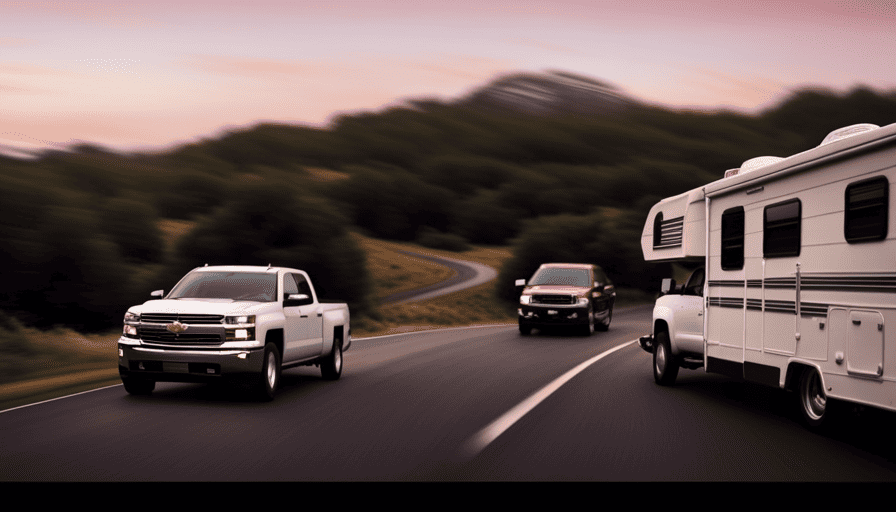Going on adventures in my beloved camper is always exciting, but it can be frustrating when pesky mice show up uninvited. These critters have a remarkable ability to slip into even the tiniest spaces.
But fear not, fellow adventurers, for I have unlocked the secret to keeping these furry intruders at bay. In this article, I will share with you my tried and true methods for keeping mice out of my camper.
From inspecting for potential entry points to using natural deterrents and even considering ultrasound devices, I’ve got you covered.
So, grab a cup of coffee, sit back, and let’s ensure that our camper remains a mouse-free haven for all our future escapades.
Key Takeaways
- Inspect the camper for entry points and seal any cracks, holes, or damaged weather stripping.
- Use mouse-proof containers for food storage and keep the camper clean and free of crumbs or food residue.
- Consider using natural deterrents like peppermint oil or essential oils, or set up traps or bait stations in strategic locations.
- Regularly check and clean the camper for signs of mice and consider professional pest control services for long-term prevention measures.
Inspect your camper for potential entry points
Take a flashlight and thoroughly inspect your camper for any potential entry points that those pesky mice could squeeze through. It’s important to be meticulous during this process because even the tiniest cracks can serve as common entry points for these little critters. Pay close attention to areas around windows, doors, vents, and utility hookups because these tend to be the most vulnerable spots. Look for any gaps, holes, or damaged weather stripping that could provide an opening for mice to enter.
Once you’ve identified these potential entry points, it’s time to take action and prevent those unwanted guests from getting inside. Start by sealing up any cracks or holes with caulk or steel wool. Caulk is a great option for smaller gaps, while steel wool can be used to fill larger openings. Make sure to apply these materials thoroughly, ensuring a tight seal that mice can’t penetrate. Additionally, consider installing door sweeps and window screens to further fortify your camper against these pests.
By inspecting your camper for common entry points and taking the necessary prevention methods, you can greatly reduce the risk of mice finding their way in. Now, let’s move on to the next step and discuss how to seal up any cracks or holes with caulk or steel wool.
Seal up any cracks or holes with caulk or steel wool
First things first, buddy, get that caulk or steel wool ready to seal up those pesky little cracks and holes in your camper. When it comes to keeping mice out, prevention is key. By sealing up any potential entry points, you can greatly reduce the chances of these unwanted guests finding their way inside.
Now, let’s talk about the materials you can use to seal those cracks. While caulk is a commonly used option, there are a few alternative materials worth considering. For instance, expanding foam can be effective for larger gaps, while copper mesh can be used for smaller openings. Just make sure to choose a material that’s sturdy and durable, as mice can easily chew through weaker substances.
Speaking of entry points, it’s important to know where to look. Common areas for mice to enter a camper include gaps around windows and doors, utility connections, and vents. Take the time to thoroughly inspect these areas and seal them up tight.
Now that you’ve sealed up those cracks and holes, it’s time to move on to the next step: using mouse-proof containers for food storage. By keeping your food secure, you’ll eliminate another tempting lure for these furry intruders. So let’s dive into this next topic and learn how to safeguard your food supply from mice.
Use mouse-proof containers for food storage
Now that you’ve sealed up those cracks and holes, it’s time to jump into the next step and ensure that your food is stored safely in mouse-proof containers. Mouse-proof containers are essential for proper food storage in your camper. Not only do they keep mice out, but they also help maintain the freshness and quality of your food.
To emphasize the importance of mouse-proof containers, let’s take a look at the following table:
| Container Type | Advantages | Disadvantages |
|---|---|---|
| Plastic bins | Durable and easy to clean | Can become brittle over time |
| Glass jars | Airtight and visually appealing | Heavy and breakable |
| Metal canisters | Rodent-proof and long-lasting | Can be expensive |
| Silicone bags | Reusable and space-saving | Not suitable for all types of food |
| Vacuum-sealed bags | Excellent for long-term storage | Requires a vacuum sealer |
By using these mouse-proof containers, you can effectively protect your food from mice and other pests. Remember to choose the right type of container based on your needs and preferences.
Now, let’s move on to the next section and explore how to keep your camper clean and free of crumbs or food residue.
Keep your camper clean and free of crumbs or food residue
Maintaining a spotless camper and ensuring there’s not a crumb or trace of food residue left behind is crucial in the battle against unwanted visitors. Keeping your camper clean is one of the most effective prevention methods to keep mice out.
Here are some cleaning tips to help you achieve a mouse-free environment. Firstly, sweep and vacuum your camper regularly to eliminate any food particles or crumbs that mice could be attracted to. Pay special attention to areas near the stove, dining area, and storage spaces. Additionally, wipe down countertops, tables, and other surfaces with a disinfectant cleaner to remove any lingering food residue.
Next, make sure to properly store all food in mouse-proof containers. Mice can easily chew through plastic bags or cardboard boxes, so opt for airtight containers made of glass or metal. This will not only keep your food safe from mice but also help maintain a clean and organized camper.
Lastly, don’t forget to take out the trash regularly and keep it in a sealed container outside of your camper. Leaving trash inside can attract mice and other pests, so be sure to dispose of it properly.
By following these cleaning tips and prevention methods, you can significantly reduce the chances of mice infesting your camper. In the next section, we’ll explore the use of natural deterrents like peppermint oil or mothballs to further enhance your defense against these pesky critters.
Use natural deterrents like peppermint oil or mothballs
To enhance your defense against these pesky critters, try using natural deterrents like peppermint oil or mothballs. These natural options can help keep mice out of your camper without the use of harsh chemicals or toxins.
Here are four effective ways to utilize these natural deterrents:
-
Place cotton balls soaked in peppermint oil near entry points or areas where mice are likely to enter. The strong scent of peppermint is known to repel mice and discourage them from entering your camper.
-
Scatter mothballs around the perimeter of your camper or in areas where mice are commonly found. The pungent odor of mothballs can act as a deterrent and keep mice at bay.
-
Consider using essential oils like eucalyptus, lavender, or citrus as additional natural deterrents. These scents are unpleasant to mice and can help discourage them from entering your camper.
-
Keep your camper well-ventilated to prevent the buildup of moisture, as mice are attracted to damp environments. Use fans or open windows to ensure proper airflow.
When it comes to the effectiveness of natural deterrents, peppermint oil is often favored over mothballs due to its pleasant scent and non-toxic nature. However, if you prefer an alternative, there are other natural deterrents available, such as ultrasonic devices or homemade repellent sprays.
By incorporating these natural deterrents into your camper maintenance routine, you can create an inhospitable environment for mice, reducing the likelihood of an infestation.
In the next section, we’ll discuss how to set up traps or bait stations in strategic locations to further protect your camper from these unwanted guests.
Set up traps or bait stations in strategic locations
One great way to ensure a mouse-free camper is by strategically placing traps or bait stations in key areas. When it comes to mouse control, the debate between traps and bait is a common one. Traps are a traditional method that physically captures the mice, while bait stations offer a more indirect approach by enticing them to consume poison. Both methods have their advantages and disadvantages.
Traps allow for immediate removal of the mice, preventing any further damage or infestation. However, they require regular checking and disposal of the trapped mice, which can be unpleasant. On the other hand, bait stations are more convenient as they require less maintenance, but they may not be as effective in eliminating the entire mouse population.
Another aspect to consider is the use of natural deterrents versus chemical repellents. Natural deterrents like peppermint oil or mothballs are widely used in campers as they’re eco-friendly and pose no harm to humans. However, their effectiveness may vary, and they need to be reapplied regularly. Chemical repellents, on the other hand, offer a stronger and longer-lasting solution, but they may contain harmful ingredients. It’s important to weigh the pros and cons of each option and choose the one that best suits your needs.
To further enhance the effectiveness of traps or bait stations, it’s crucial to remove any potential nesting materials from your camper. This will discourage mice from taking up residence and reduce the likelihood of re-infestation.
Remove any potential nesting materials from your camper
Clear out any materials that mice could use for nesting in your camper. This is an essential step in preventing these unwanted critters from making a home in your vehicle.
Mice are resourceful and can use a variety of items for nesting, so it’s important to be thorough in your search. Here are three key items to focus on when removing potential nesting materials from your camper:
-
Upholstery and Fabrics: Inspect all upholstery, cushions, and curtains for any signs of damage or holes. Mice can easily chew through these materials and use the fibers for their nests. Remove any damaged or torn items and replace them with mouse-resistant alternatives.
-
Paper and Cardboard: Mice love to shred paper and cardboard to create cozy nests. Remove any unnecessary paper products, such as old magazines or cardboard boxes, from your camper. Store important documents in sealed containers to prevent mice from accessing them.
-
Insulation and Wiring: Mice can also chew through insulation and wiring, causing potential damage to your camper’s electrical system. Inspect these areas carefully and repair any damage promptly. Consider using rodent-proof insulation and wiring to deter mice from nesting in these areas.
By removing potential nesting materials from your camper, you’re taking proactive measures to keep mice away. However, it’s important to regularly check and clean your camper for signs of mice to ensure that your preventive efforts are successful.
Regularly check and clean your camper for signs of mice
Make sure you’re regularly on the lookout and cleaning your camper for any telltale signs of those unwanted critters. Inspecting techniques and pest control methods are essential to keep mice out of your camper. By regularly checking and cleaning your camper, you can identify any signs of mice and take immediate action to prevent an infestation.
To effectively inspect your camper, create a checklist of areas to examine. Inspect the exterior for any holes or gaps that mice could use to enter. Pay attention to the undercarriage, vents, and windows, as these are common entry points. Inside the camper, check for droppings, chew marks, and nesting materials. Inspect cabinets, drawers, and hidden corners thoroughly.
To keep your camper clean and unappealing to mice, use a vacuum cleaner with a hose attachment to remove crumbs and debris. Wipe down surfaces with a disinfectant to eliminate food and scent trails. Additionally, consider using peppermint oil or ammonia-soaked cotton balls to deter mice.
Transitioning to the next section, consider using ultrasound devices to repel mice. These devices emit high-frequency sounds that are unpleasant to mice, driving them away from your camper.
Consider using ultrasound devices to repel mice
Now that you’ve learned the importance of regularly checking and cleaning your camper for signs of mice, let’s explore another effective method to keep those pesky critters away. Consider using ultrasound devices as a deterrent. These devices emit high-frequency sound waves that are inaudible to humans but highly irritating to mice, making them want to steer clear of your camper.
Ultrasound devices have proven to be quite effective in repelling mice, as they create an environment that is uncomfortable and unpleasant for them. Simply plug in the device and let it work its magic, creating a barrier that mice won’t want to cross.
While ultrasound devices are an excellent option, it’s important to note that they’re not the only alternative deterrent available. You can also explore other options such as natural repellents, peppermint oil, or even homemade traps. The key is to find a method that works best for you and your camper.
If, despite your best efforts, the mice problem persists, it may be time to consult a professional pest control service. These experts have the knowledge and tools to effectively address the issue and provide you with long-term solutions. Remember, it’s better to tackle the problem head-on to ensure a rodent-free and enjoyable camping experience.
Consult a professional pest control service if the problem persists
If the mice problem in your camper refuses to relent, it might be time to bring in the experts – a professional pest control service can swoop in like a superhero to save the day. While there are various DIY methods you can try, sometimes the infestation is too stubborn or widespread for these remedies to be effective.
Consulting a professional pest control service ensures that you have access to the expertise and resources needed to tackle the issue head-on. When you hire a professional pest control service, they’ll conduct a thorough inspection of your camper to identify all potential entry points and nesting areas. They’ll then develop a customized plan to eliminate the existing infestation and prevent future ones.
This plan may include the use of traps, baits, and other specialized techniques to target mice specifically. Additionally, they’ll provide you with valuable advice on long-term prevention methods to keep mice out of your camper. Professional pest control services have access to products and equipment that may not be readily available to consumers. They’re trained to handle these substances safely and effectively. By relying on their expertise, you can be confident in the elimination of the mice problem in your camper and the implementation of long-term prevention measures.
Remember, prevention is key. After the professional pest control service has eradicated the mice, it’s crucial to follow their recommendations for long-term prevention. This may involve sealing any potential entry points, storing food properly, and keeping your camper clean and clutter-free. If your mice problem persists despite your best efforts, consulting a professional pest control service is a wise decision. They have the knowledge, experience, and resources to effectively eliminate the infestation and provide you with long-term prevention methods. Don’t let the mice take over your camper – take action and reclaim your space with the help of professionals.
Frequently Asked Questions
What are some common signs that mice may be present in my camper?
To prevent mice from entering your camper, there are several steps you can take. Firstly, seal any gaps or cracks where mice could enter using steel wool or caulk to block their access points.
Secondly, keep your camper clean and tidy, as mice are attracted to food and clutter.
Additionally, consider using natural remedies such as peppermint oil, vinegar, or mothballs to deter mice.
Regularly inspect your camper for signs of droppings, chewed wires, or nests to detect their presence early.
Are there any specific types of caulk or steel wool that are more effective at sealing up cracks and holes?
Caulk and steel wool are both effective materials for sealing up cracks and holes. When it comes to caulk, look for a high-quality silicone caulk that’s specifically designed for outdoor use. This’ll ensure a strong and long-lasting seal.
As for steel wool, opt for a fine grade that’s easy to work with and tightly packs into crevices. Alternatively, expanding foam or wire mesh can also be used to seal openings. Remember, thoroughness and attention to detail are key when it comes to keeping mice out of your camper.
Can I store food in regular containers as long as they are properly sealed?
When it comes to storing food safely, it’s important to consider alternative storage options. While regular containers may seem convenient, they may not provide the necessary protection against pests like mice. It’s best to opt for airtight containers specifically designed for food storage. These containers not only keep your food fresh but also prevent unwanted visitors from getting in. Don’t compromise the safety of your food by using inadequate storage solutions.
Are there any specific cleaning products that are more effective at repelling mice?
There are several specific cleaning products that can be effective at repelling mice. One option is peppermint oil, which has a strong scent that mice dislike.
Another option is vinegar, as the strong odor can deter mice from entering your camper.
Additionally, using a mixture of baking soda and powdered sugar can be an effective natural repellent. It’s important to regularly clean your camper with these products to maintain a mouse-free environment.
How often should I check and clean my camper for signs of mice?
I recommend checking your camper for signs of mice at least once a month. Some common signs to look out for include droppings, chewed wires or insulation, and nests made of shredded materials.
Regularly inspecting your camper will allow you to catch any potential mouse infestations early on and take appropriate action. By staying vigilant and addressing any signs of mice promptly, you can prevent further damage and ensure a rodent-free camping experience.
Conclusion
In conclusion, keeping mice out of your camper requires diligence and proactive measures. By inspecting and sealing any potential entry points, using mouse-proof containers for food storage, and keeping your camper clean, you can significantly reduce the likelihood of a mouse infestation.
Some may argue that natural deterrents like peppermint oil or mothballs aren’t effective, but many campers have found success with these methods. Remember to regularly check and clean your camper and consider using ultrasound devices as an additional measure.
If the problem persists, it may be necessary to consult a professional pest control service.
Happy camping!










